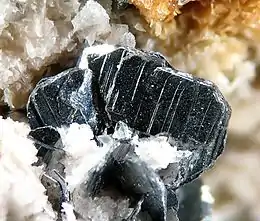Nagyágite
Nagyágite (Pb
5Au(Te,Sb)
4S
(5-8)) is a rare sulfide mineral with known occurrence associated with gold ores. Nagyágite crystals are opaque, monoclinic and dark grey to black coloured.
| Nagyágite | |
|---|---|
 Nagyágite from Nagyág (Săcărâmb), Romania (image width: 1.5 mm) | |
| General | |
| Category | Sulfosalt mineral |
| Formula (repeating unit) | Pb 5Au(Te,Sb)} 4S (5-8)[1] or AuPb(Sb,Bi)Te (2-3)S 6[2] or (Te,Au)Pb(Pb,Sb)S2[3] |
| IMA symbol | Ngy[4] |
| Strunz classification | 2.HB.20a |
| Dana classification | 02.11.10.01 |
| Crystal system | Monoclinic |
| Crystal class | Prismatic (2/m) (same H-M symbol) |
| Space group | P21/m |
| Identification | |
| Colour | Blackish lead-grey; pale grey in polished section |
| Crystal habit | Tabular crystals (often bent), also massive granular, pseudotetragonal |
| Twinning | Crossed twin lamellae observed on (001) sections |
| Cleavage | Perfect on {010}, excellent on {101} |
| Fracture | Hackly |
| Tenacity | Flexible, slightly malleable |
| Mohs scale hardness | 1.5 |
| Lustre | Metallic, bright on fresh cleavage |
| Streak | Blackish lead-grey |
| Diaphaneity | Opaque |
| Specific gravity | 7.35–7.49 |
| Pleochroism | Weak |
| References | [1][2][3] |
It was first described in 1845 for an occurrence at the type locality of the Nagyág mine, Săcărâmb, Hunedoara County, Romania.[1][2]
It occurs in gold–tellurium epithermal hydrothermal veins. Minerals associated with nagyágite include: altaite, petzite, stutzite, sylvanite, tellurantimony, coloradoite, krennerite, native arsenic, native gold, proustite, rhodochrosite, arsenopyrite, sphalerite, tetrahedrite, calaverite, tellurobismuthite, galena and pyrite.[3]
References
- http://www.mindat.org/min-2830.html Mindat.org
- http://webmineral.com/data/Nagyagite.shtml Webmineral data
- http://rruff.geo.arizona.edu/doclib/hom/nagyagite.pdf Handbook of Mineralogy
- Warr, L.N. (2021). "IMA–CNMNC approved mineral symbols". Mineralogical Magazine. 85: 291–320.
| Wikimedia Commons has media related to Nagyágite. |
This article is issued from Wikipedia. The text is licensed under Creative Commons - Attribution - Sharealike. Additional terms may apply for the media files.